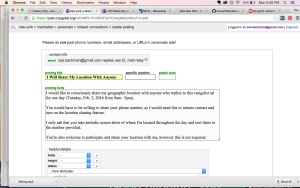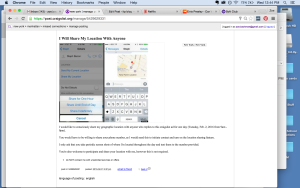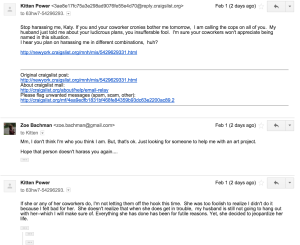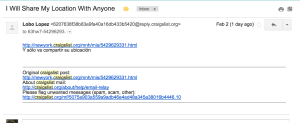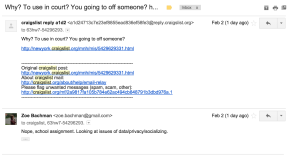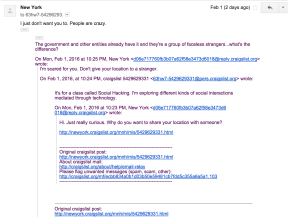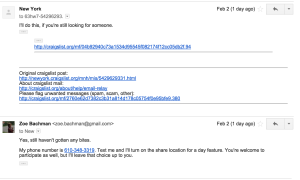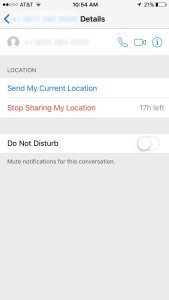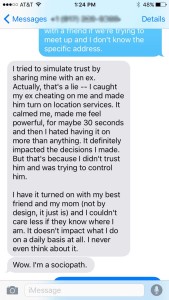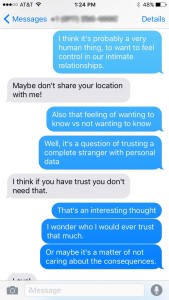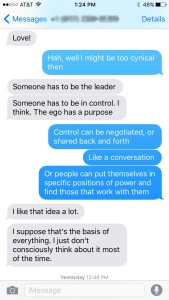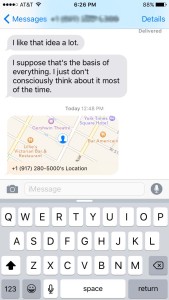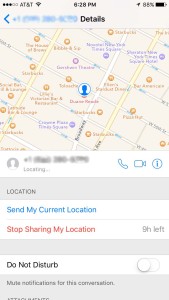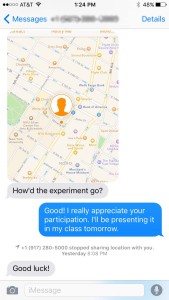Social Hacking, Week 1: I Will Give Anyone My Location
For our first week, we had to reinterpret Steve Lambert’s “I Will Talk With Anyone” with our own personal flavor.
I found this assignment very interesting 1. Because Steve Lambert is a well-known social practice artist and that’s something I always dig 2. Because in reality, Steve’s piece is very specific.
What I mean is, in trying to recreate or do a variation on the piece, what aspects do we choose to preserve and which do we choose to alter? And what effect do these changes have on the concept and essence of a piece?
There is a beautiful simplicity and specificity to the original. What more pure social interaction is there beyond a conversation? About anything?
And then there’s the specific context of the original piece. Playing off of a tradition of setting up tables in a public space (what we called ‘tabling’ in college), Steve uses a social situation that many are familiar with but instead of forcing others into having a conversation, he invites them in. Even better, that person gets to choose what they want to talk about, rather than be forced into a conversation about religion or war, etc. He intentionally uses visuals and context to provide a familiar and seemingly easier environment. It’s actually pretty amazing to think about what the piece did – he managed to create an opportunity for social interaction with a stranger that some how seemed less threatening than its initial context.
I had a hard time coming up with an idea I liked. I tried thinking about the basic ideas behind the project: exchange/barter, interaction, intimacy/vulnerability.
What ended up interesting me most was the idea of generating intimacy with someone unknown and creating feelings of vulnerability. Part of me wanted to move beyond the conversation as exchange and imagine another type of exchange – perhaps one that did not hold the same kind of balance as a conversation and specifically made me the vulnerable person. Because in our reality, how often are interactions and social relationships actually equal?
I chose to share my location for a day with a stranger and invite them to reciprocate.
While Lambert’s piece takes place in a public space, I wanted to acknowledge how many human interactions are now unseen. When we perform actions online, we sometimes forget about the other humans on the other side who see their results. Faceless workers at Apple, Google and the NSA look at our data, but they’re still individuals with wants/needs/lives processing/review our personal information. What difference is there between a paid facebook employee reviewing posts and giving access to another faceless stranger?
This piece is a conscious coupling with unknowable consequences.
Where does the power and control lie? In the person designing the interaction or the person agreeing to observe?
I decided that I would use Craigslist to put my message out into the public sphere and invite strangers to participate. At first, I couldn’t decide what category would make it most visible. I first went for the community-volunteers section because contextually that seemed the best fit. But then I thought about where people actually live on Craigslist and posted it again under Missed Connections. My thought behind the choice was that people look at Missed connections because they hope that someone is searching for them, which essentially was what I was doing.
About half an hour later I got my first email.
and some others…
My most significant interaction came from a person who used the handle “New York”. They were curious about the project, but also very concerned for my personal safety.
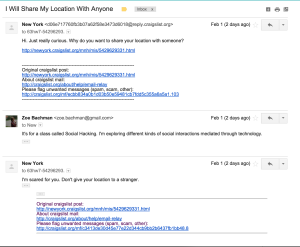
This and the Kitten Power emails brought up the underlying question of mental illness. It seemed that people on Craigslist were divided between assuming that I’m crazy and trying to harass them or that other crazy people will harass me.
I was preparing to execute my plan B idea, but then New York offered to participate if no one else did (no one else did, or has).
I gave them my phone number and turned location services on.
Honestly, I thought that would be it. I mean, besides receiving screenshots.
Instead, the person started asking me questions about the project and we got into a full blown discussion about relationships, power and control

For someone who had warned me against doing this with other people, I find it funny that they also accused themselves of being “crazy”. But it mostly seemed like they just wanted to talk a bit. (I realize now I could have pushed that interaction further.)
They also decided after talking for a while to share their location with me, which I didn’t notice for a couple of hours.
Like I mentioned in my text exchange, doing this project definitely made me more aware of my location and movements (mostly, how I hadn’t moved from ITP since 11am). But there was an odd sense of reassurance, perhaps since I’m used to having this relationship of sharing my location with my family…? As someone new to the city and still forming close relationships, I guess I liked the idea that in a way, someone was looking out for me. I wonder if I would have had the same emotional experience had I not had such an extended text conversation with the participating individual.
The piece also became a way of reconsidering danger and bodily harm. Like I mentioned before, people assumed that sharing such “personal” information meant that I either wasn’t right in the head or that such an offer would attract people who could potentially be mentally ill and thus possibly violent. I wonder how certain environments engender mistrust. But also that these people are the same people who are probably just as ok with the faceless corporate/government employees looking at this exact same information. Is it the physical proximity? That I chose to post in a city where if someone wanted to, they could come and find me and do something terrible if they so wanted? I wonder if I posted this on a craigslist in a different city if I would have gotten more responses because I would be deemed as “non-physically-threatening”.
